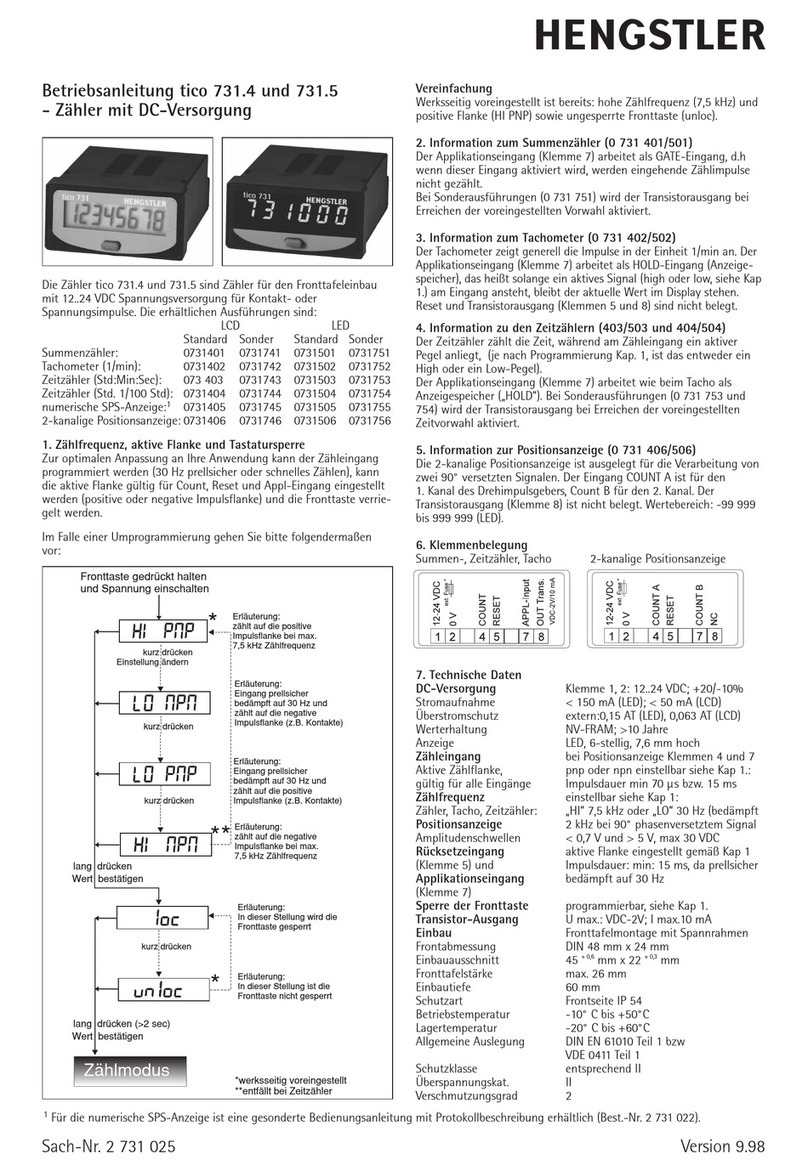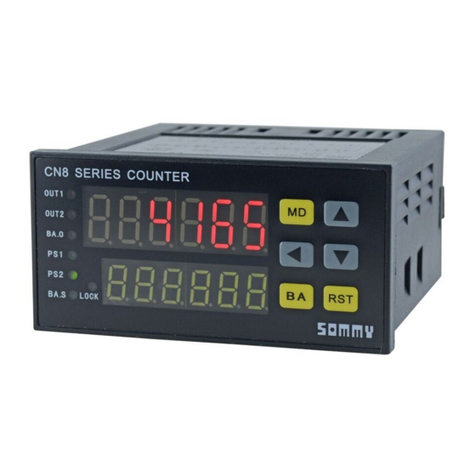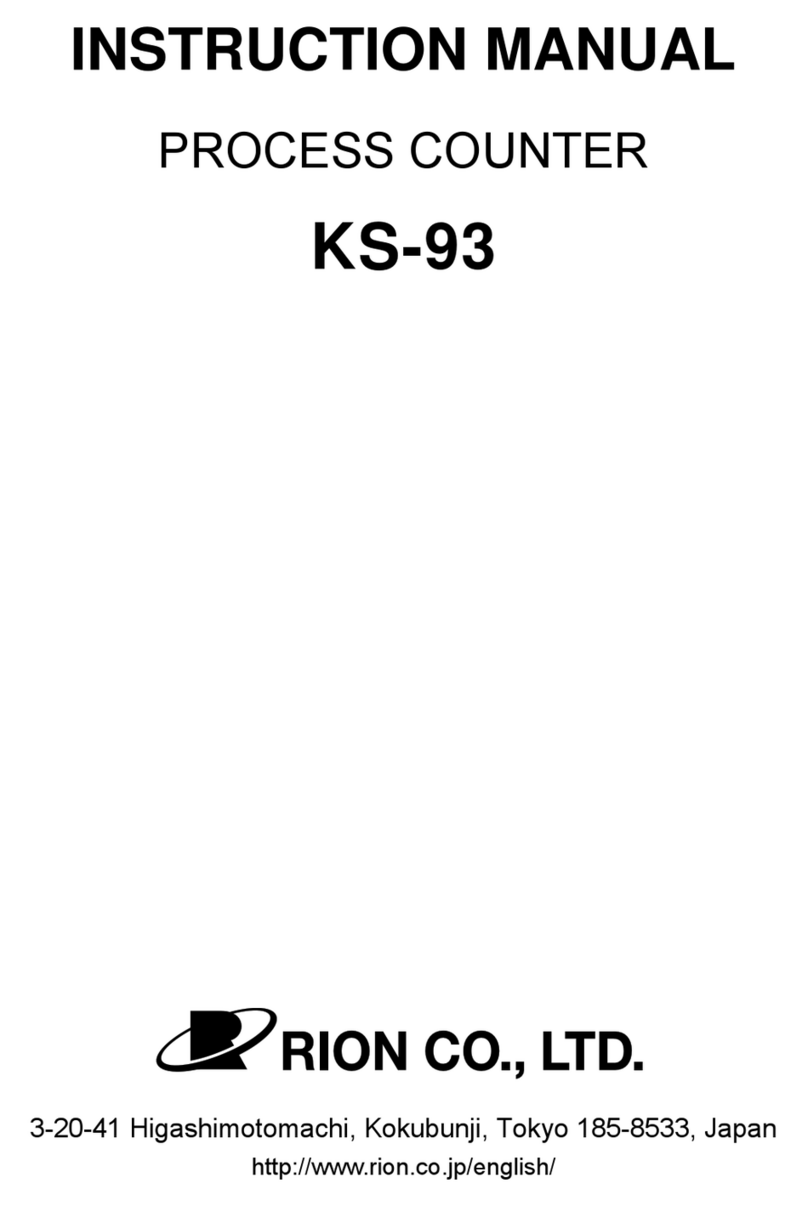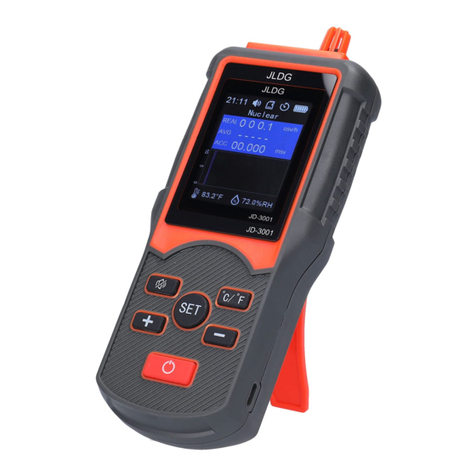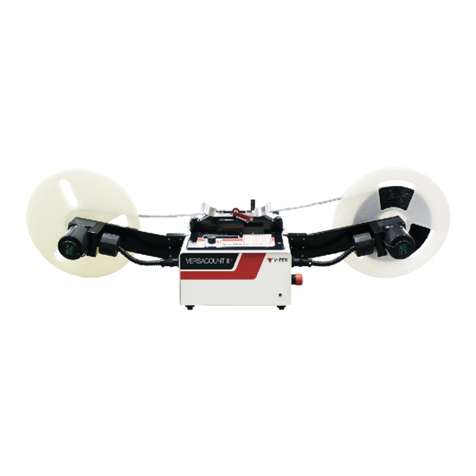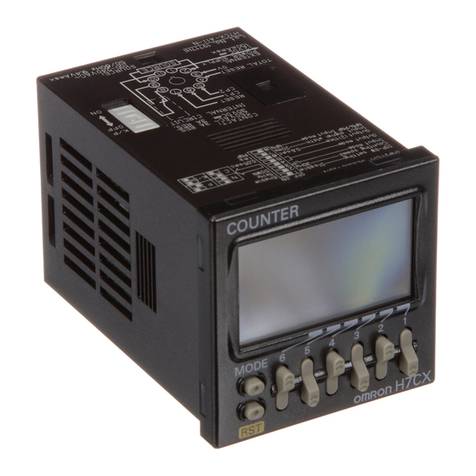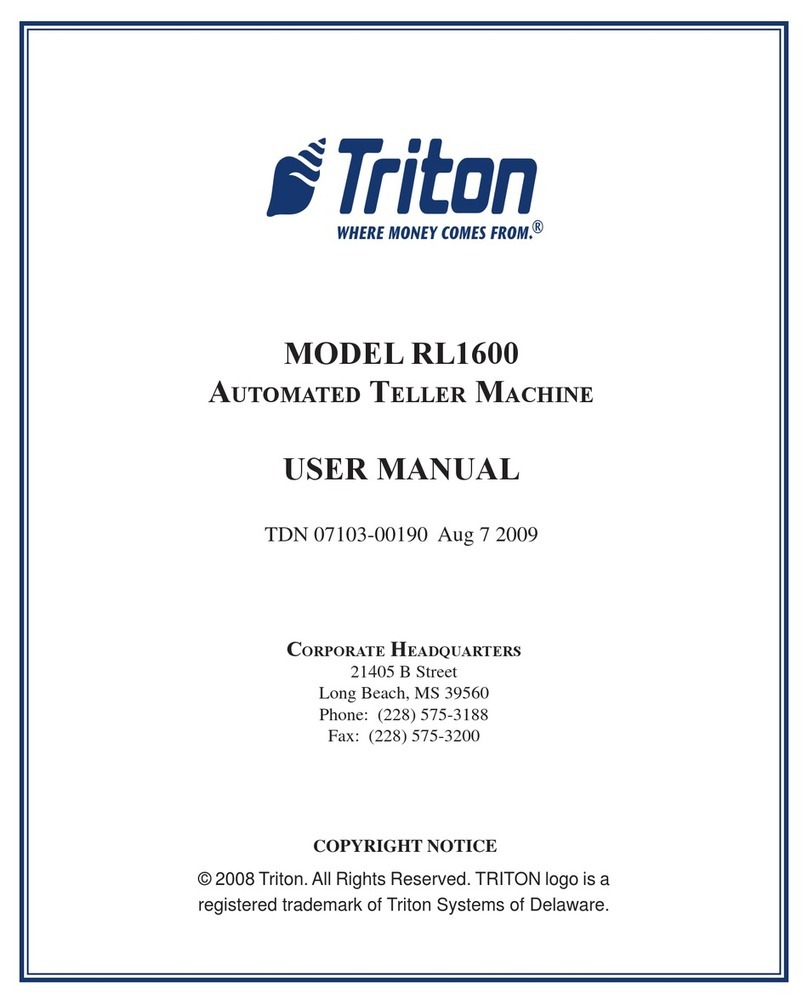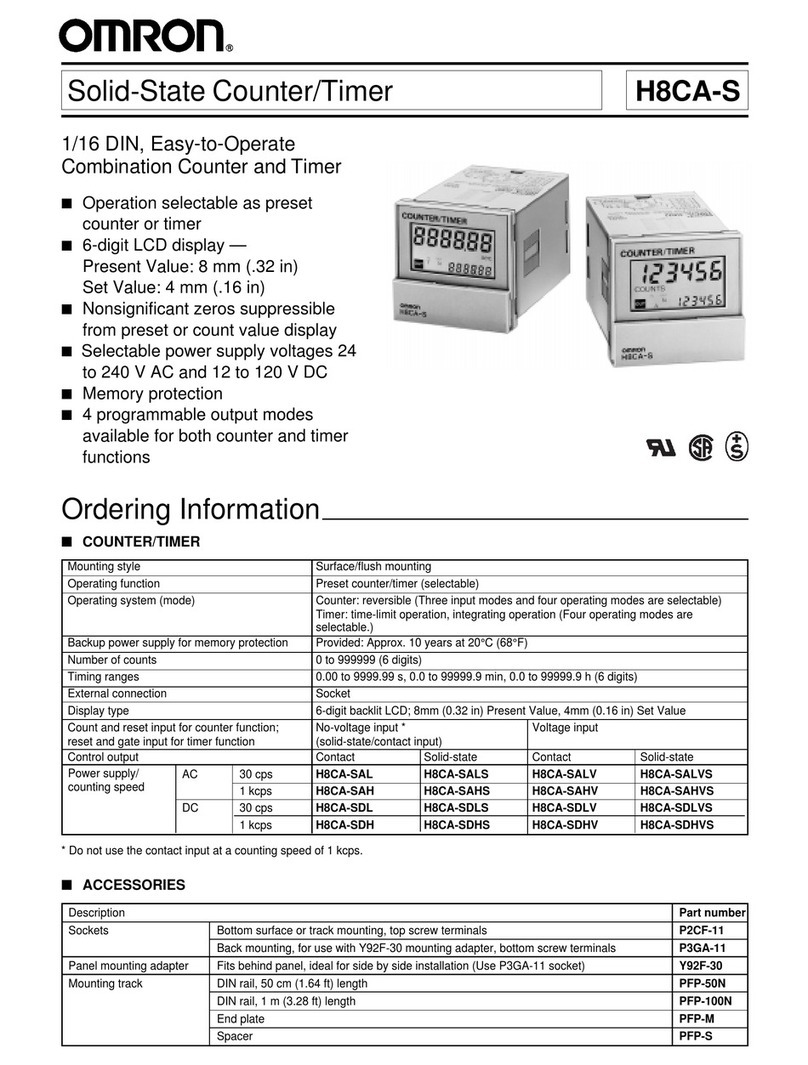Hengstler tico 772 User manual

User Manual
bidirectional
Multifunctional-Counter
Part-No. 2 772 083 englisch; 05/2011
Original language German
English translated from German
English

III
1 General Information 7
1.1 Information about the Operating Instructions 7
1.2 Explanation of symbols 8
1.3 Limitation of Liability 9
1.4 Copyright protection 10
1.5 Guarantee conditions 10
1.6 Customer Service 10
2 Safety 11
2.1 Intended Use (Proper Use) 11
2.2 Assembly, connecting, programming 12
2.3 Responsibilities of the machine/plant manufacturer
and operator 14
2.4 Staff-related requirements 15
2.5 Special hazards 16
2.6 Safety devices 17
3 Setup and Operation 18
3.1 Dimension Sheet / Multifunction Counter Installation 19
3.2 Connecting the Multifunction Counter 19
3.3 Display 21
3.4 Keyboard functions 22
3.5 Overview of Operating Elements 24
3.6 Programming the Standard Function 25
3.7 Programming the Function Codes 26
3.8 Programming the Preset Modes 27
3.9 Prescaler Programming 29
3.10 Programming the (User) Times 30
3.11 Output of ID Data 31
3.12 Adjusting the intensity of the backlight 32
Table of Contents

IV V
4 General Description of Multifunctional Counter 33
5 Pulse Counter 38
5.1 Description of Pulse Counter 38
5.2 Signal diagrams – counter input signals 39
5.3 Signal diagrams – counter output signals 41
5.4 Programming the counter function codes 43
6 Tachometer 55
6.1 Tachometer description 55
6.2 Signal diagrams - tachometer 56
6.3 Programming the tachometer function codes 57
7 Timer 66
7.1 Timer description 66
7.2 Signal diagram – timer input signals 68
7.3 Signal diagrams – timer output signals 69
7.4 Programming the timer function codes 70
8 Shift Counter 83
8.1 Shift counter description 83
8.2 Scroll between Total Sum and Partial Sums 84
8.3 Signal diagrams – shift counter input signals 84
8.4 Signal diagrams – shift counter output signals 85
8.5 Programming the shift-counter function codes 86
9 Batch Counter 97
9.1 Batch counter description 97
9.2 Signal diagrams – batch counter 98
9.3 Programming the batch counter function codes 98
Table of Contents
10 Technical Data 111
11 Transport, Packaging, Storage 118
12 Maintenance and cleaning 118
13 Malfunctions 119
14 Spare Parts 121
15 Dismantling and Disposal 121
16 Ordering Information 122
17 Accessories and spare parts 123
Table of Contents

VI VII
1 General Information
1.1 Information about the Operating Instructions
These operating instructions provide important information about the hand-
ling of the multifunctional counter. To ensure safe operation it is vital that the
safety information and instructions be strictly observed.
For Counters with interfaces Tico 773 and Tico 774 please see the amendment
0 773 001
The multifunctional counter has been designed for industrial use and for ins-
tallation in machinery or industrial plants.
The manufacturer of the machine/plant in which the multifunctional counter
is used has to ensure that the function of the counter is properly described in
the Operating Instructions of the machine or plant, and that the description is
in accordance with manufacturer’s programming functions.
The manufacturer’s safety rules shall be applicable.
In addition, the local regulations concerning the prevention of accidents and
general safety information applicable to the machinery/plant shall be adhered
to.
Before starting any work on the machine/plant, the operating instructions and
in particular, the Safety chapter and the respective safety information must be
fully read.
These operating instructions are an integral part of the product and must be
maintained in the direct vicinity of the machine/plant and in a place that is
readily accessible for the operating staff.
These operating instructions contain important information concerning the in-
stallation, connection and programming of the multifunctional counter.
General Information

8 9
Description of the programming sequence:
- Programming of the basic functions
- Programming of the function codes
- Programming of the user times
- Programming of the prescaler
- Programming of the presettings
Before starting to run the machine/plant, all functions that are not allowed to
be changed by the operator have to be blocked.
The executed programming functions have to be
documented.
1.2 Explanation of symbols
The warnings in these operating instructions are designated by symbols. Signal
words at the beginning of the warnings indicate the severity of a safety ha-
zard.
These notes have to be observed by all means, and all actions have to be taken
with utmost care so as to prevent any accidents or damage or personal injury.
Danger!
This warning indicates a direct safety hazard,
which may lead to serious injuries or even death if
preventative action is not taken.
Warning!
This warning indicates a possible safety hazard,
which may lead to serious injuries or even death if
preventative action is not taken.
General Information
Caution!
This warning indicates a possible safety hazard,
which may lead to minor damage or injuries if
preventative action is not taken.
Note!
This symbol indicates a potentially hazardous
situation, which may lead to damage to property
or to the environment if preventative action is not
taken.
Tips and recommendations
This symbol is used to point out to useful tips and
recommendations and information ensuring effici-
ent and trouble-free operation.
1.3 Limitation of Liability
The information and notes contained in these operating instructions were
gathered in accordance with the applicable standards and regulations, the
state-of-the-art, as well our long-standing experience and know-how.
The manufacturer shall not assume any liability for damage caused by:
- Non-adherence to the operating instructions
- Improper use
- Employment of unskilled or untrained personnel
- Makeshift changes or manipulation
- Opening of the multifunctional counter
As a result of special design versions, special ordering options or the latest
technical developments, the actual scope of delivery may deviate from the
scope described and illustrated here.
General Information

10 11
1.4 Copyright protection
The operating instructions must be treated confidentially and used exclusively
by the personnel responsible for the setup, maintenance, repair and operation
of the machine/plant. Disclosure of these operating instructions to any third
parties shall not be permissible without the prior written consent of the ma-
nufacturer.
The data and information stated here, including
text, drawings, images and other illustrations, are
protected by copyrights and subject to industrial
property rights. Any misuse of such information
shall be subject to prosecution.
1.5 Guarantee conditions
Our guarantee conditions are available for download from our homepage at
www.hengstler.com – DOWNLOAD – General Terms & Delivery Terms.
1.6 Customer Service
Our customer service is available to provide technical information and assis-
tance for our customers. Detailed information on your responsible contact
partner is given on our homepage (www.hengstler.com) under Contact and
How to find us.
General Information
2 Safety
This section provides an overview of all the important safety-relevant aspects
to ensure best possible protection of the operating personnel as well as safe
and trouble-free operation. Non-adherence to the instructions given in this
manual may result in considerable safety hazards.
2.1 Intended Use (Proper Use)
The multifunctional counter is exclusively designed and constructed for the
intended use and purposes described here.
The multifunctional counter serves together with a corresponding sensor
for the counting of piece numbers, lengths, flow rates, velocities and
times, as well as for the controlling and monitoring of machinery and
equipment by sending control signals.
Warning!
Safety hazards due to improper use / misuse!
Using the multifunctional counter for any purposes
other than the ones described within the scope of
intended use may cause hazardous situations. Claims
for damages resulting from any kind of misuse
shall be expressly excluded.
Safety

12 13
2.2 Assembly, connection, programming
These multifunctional counters are built and tested in accordance with IEC/EN
61010-1, Protection Class II – Safety Measures for Electronic Measuring
Equipment. They have left the factory in a condition that is in compliance with
all safety-relevant requirements. In order to maintain this condition and en-
sure operational safety, the User is requested to observe the safety notes and
warnings given in these operating instructions!
Danger!
Risk of safety hazards due to incorrect/faulty as-
sembly and connection.
• The max. operating voltages must not be exceeded!
• 12 – 24VDC and 24VAC multifunctional counters have to be operated at
safety extra-low voltages (SELV) and under potential-compensated condi-
tions in order to prevent hazardous shock currents.
• An external fuse has to be provided to protect the multifunctional counter
(see Chapter 10, Technical Data).
• Installation and assembly shall be carried out by skilled and trained electri-
cians only.
• Do not connect the multifunctional counter without making sure that it no
longer carries any live voltages. Always separate it from the mains supply
before connecting.
• Make sure that live terminals are properly protected against inadvertent
contact.
• To ensure proper protection of terminals against hand contact, make sure
that the live conductors are properly connected to the terminals.
• It‘s not allowed to use the multifunctional counter outside of the specified
temperature range. If neccessary appropriate precoutions have to be applied
Safety
(e.g. air ventilation).•The rules and regulations set forth by the local elec-
tricity providers have to be observed.
• Do not establish any connections with non-allocated (NC) terminals.
• Multifunction counters may only be operated in a properly installed condi-
tion.
• If safe operation seems to be impaired, make the multifunctional counter
inoperable and secure it against inadvertent operation.
• Scope of applications: industrial processes and controls. Overvoltage across
the terminals must be limited to the values of overvoltage category II.
• The installation and wiring environment has considerable impact on the
electromagnetic compatibility of the multifunctional counter. Therefore,
electromagnetic compatibility of the entire plant has to be ensured during
the installation.
• In areas presenting the risk of ESD (electrostatic discharge), make sure to
use ESD-protected plugs and switches during the installation.
• If the functions “prescaler input”, “preset input” and “key reset” are not al-
lowed to be used by the machine/plant operator, access to these functions
must be blocked for machine operators. Depending on the machine/plant
design or concept, non-permissible input may impair the operational safety
and function of the machine or plant.
Danger!
The manufacturer of the machines / plants has to
ensure, that no risks result from this.
• The machine/plant manufacturer shall be responsible for the preparation of
operating instructions / plant description including the following:
Safety

14 15
• Description of functions according to the programming of the multifunc-
tion counter;
• Description of the settings to be adjusted by the machine/plant operator;
• Information concerning the occupational safety requirements and possi-
ble hazards arising from the operation of the machine/plant.
2.3 Responsibilities of the machine/plant manufacturer
and operator
Multifunctional counters are designed for installation in machines/plants.
Therefore, the manufacturer and
operator of the machine/plant are subject to the legal obligations concer-
ning occupational safety and health.
Besides the safety notes given in these operating instructions, the relevant
rules and regulations concerning safety and the prevention of accidents,
and the applicable environmental requirements have to be met. In particu-
lar:
• The machine/plant manufacturer shall be obligated to ensure that all the
requirements mentioned in section 2.2 be fulfilled during the assembly,
connection and programming.
• The operator shall obtain all the required information about the applicable
occupational safety rules. In addition, the operator shall be obligated to
prepare a risk assessment of possible hazards that may arise due to the spe-
cial working conditions at the place of installation of the machine/plant.
This risk assessment shall be documented in the form of operating instruc-
tions for the machine/plant.
• Throughout the entire operating time of the machine/plant the operator
shall be obligated to check if the operating instructions prepared are in ac-
cordance with the latest status of requirements and, if required, make the
appropriate adjustments.
Safety
• The operator shall ensure that all staff members who are involved in the
machine/plant operation have read and fully understood these instructions.
Moreover, the operator shall be obligated to train the operating personnel
at regular intervals and inform them about any potential hazards.
• The operator shall ensure that the operation and cleaning of the machine/
plant is exclusively carried out by skilled and trained personnel.
• The operator shall ensure that all maintenance and repair work shall only
be carried out by skilled and trained personnel.
2.4Staff-related requirements
Warning:
Danger of personal injuries if handled by insuffici-
ently qualified staff! Improper handling may cause
severe personal injuries and damage to property.
• Actions requiring special skills have to be carried out only by the personnel
designated in the appropriate sections of these instructions.
• Keep unqualified personnel away from hazard areas.
The following staff qualification requirements have been
defined for the various scopes of activities:
• Instructed personnel
These persons have been instructed by the operator with regard to the tasks
assigned and the potential hazards caused by improper handling.
• Skilled personnel
Due to their educational and professional skills, know-how and experience,
as well as due to their knowledge of the relevant regulations, these persons
are capable of executing their assigned tasks and recognize potential ha-
zards independently.
Safety

16 17
• Skilled and trained electricians
Due to their educational and professional skills, know-how and experience,
and due to their knowledge of the relevant regulations in the field of elec-
trical engineering, these persons are capable of executing electrical work
and recognizing potential hazards independently.
2.5 Special hazards
This section indicates certain residual risks, which may arise as a result of the
risk assessment.
The safety information and warnings given here and in the following chapters
of these instructions have to be observed in order to reduce any health ha-
zards and avoid hazardous situations.
Electric current
Danger!
Lethal hazard of electric shock!
Any contact with hazardous live components pre-
sents a direct lethal hazard.
Damages of the insulation or individual compo-
nents present a potential lethal hazard.
• In the event of any damage to the insulation, imme-
diately disconnect the voltage supply and initiate the
appropriate repair work.
• Any work on the electrical plant has to be carried out
by skilled and trained electricians only.
• Before commencing your work on the electrical system,
disconnect it from the main supply and check that it
no longer carries any live voltages.
Safety
• Prior to conducting any maintenance, cleaning or repair
work, disconnect the mains supply and secure it against
inadvertent switching on.
• Do not short-circuit or make fuses inoperable.
2.6 Safety devices
Warning! Lethal hazard by non-functional safety
devices! Safety devices are provided to ensure a
maximum of operational safety.
The multifunctional counter itself does not include any installed safety de-
vices.
These safety devices have to be attached externally.
Protect the electrical supply of the multifunctional counter by means of exter-
nal fuses (see Chapter 10, Technical Data).
Whether or not additional safety devices (e.g. emergency-off buttons) have to
be provided depends on the general design and construction of the machine or
plant.
The machine/plant manufacturer shall be responsible for providing such addi-
tional safety devices in according with his own risk assessment.
Safety

18 19
3 Setup and Operation
1 Display
2 Operating keys
3 Flat gasket
4 Bracket
5 Enclosure
6 Plug for DC or sensor supply;
Electronic inputs and outputs
7 Connection terminal AC supply and relay contacts
8 Circuit diagram
Safety
3.1 Dimension Sheet /
Installation of Multifunction Counter
3.2Connecting the Multifunctional Counter
VDC 2 relays / 2 transistors VAC Trafo 2 relays / 2 transistors
VDC 1 relay / 2 transistors VAC transformer 1 relay / 2 transistors
Safety
bracket

20 21
VAC switching power supply VAC switching power supply
2 relays / 2 transistors 1 relay / 2 transistors
The plug has to be disconnected from the counter
before the cables are fastened by means of screws
or screw-type terminals.
It is not allowed to contact the encoder to a direct
current line voltage without protective circuit for
EMC. For cable lengths > 30 m a protective circuit
is always necessary!
When programming the input level to TTL an addi-
tional protective circuit is necessary.
We recommend the installation in an metallic
environment.
Setup and Operation
Only valid for DC-Versions:
When switching on the device in PNP-Mode, a short signal is applied to inputs
A,B,C and the application input.
To suppress the pulse in TTL-Mode each input has to be connected to a resis-
tor of 10 kOhm/0,125W against 0V.
When switching on the device a short signal is applied to the application out-
put.
This pulse, if needed, is possible to suppress by connecting a resistor of 10
kOhm / 0,225 W against 0 V to the application-output.
3.3 Display
After switching on, all segments and characters are illuminated for approx. 2
seconds; then the display changes over to the Display or Programming Mode.
The display is available in five different versions:
Reflectiv: black figures on bright reflecting background
Transflective positive: black figures on back lighted ground
Transmissive white: white figures on black ground
Transmissive red: red figures on black ground
Transmissive green: green figures on black ground
Setup and Operation
Prescaler

22 23
During the Programming of Function Codes
Enter - Key UP - Key Down - Key SHIFT - Key
Programming
If pressed together with POWER ON (keep keys pressed and switch on the device)
+Selects standard functions
+Sets function codes
+Selects ID data
(Article code (ID No.), manufacturing date, serial number,...)
+Sets User Times
During the Programming of Function Codes
+
Display of function code
Switches between function code text and function code
number
During Operation
+Reset
+Sets preset 0
+Sets preset 1
+Sets preset 2
+Sets prescaler
Setup and Operation
Additional function for shift and batch counters
Switches between total sum and partial sums and/or
count value and totalizer or batch counter
Additional function for timers
Timer start
(If enabled with function code F15)
Timer stop
(If enabled with function code F15)
Additional function backlight versions
Go to the adjustment menu
(pressing > 5 s)
+Adjustment of the intensity
(brighter or darker)
Save and going back to display mode
(Pressing within 15 s)
Setup and Operation

24 25
3.5 Overview of Operating Elements
Setup and Operation
Display Mode Reset
123456 up + dn 0
noitcnufdradnatS=2teserP=pu+E
retemaraPnoitcnuF=1teserP=nd+E
semitlangiS=0teserP=tfihs+E
up + shift = Prescale
r
Programming Mode Standard Funct. Function parameters:
Pulse counter Operat. Mode Count frequency
Tachometer Decimal point Reset Behavior
yromeMtuptuOedoM-teseR/teSremiT
Shift counter Display-Mode Keylock
Batch counter Output signals npn/pnp selection
Applic. Input/Output
+ many other function parameters
E + up at power on
E + dn at power on
up + shift at power on
E
Setup and Operation
3.6 Programming the Standard Function
The device described here is a multifunctional counter, which can be program-
med for a variety of functions, i.e. pulse counter, tachometer, timer, shift
counter or batch counter functions. The first step is to set the standard func-
tion (the factory setting of the device is the “pulse counter” setting).
Now continue with the programming of the function codes (Chapters 5-9) or
User Times (Chapter 3.10)
Programming mode Change function
setting:
Save, return to counter
operation
+or
Keep pressed and
switch voltage on
simultaneously
press press
Function code Fn, Display Row 1
Function No. Display
Row 2
Setting of
Standard
Function
0*
Pulse counter
1
Tachometer
2
Timer
3
Shift Counter
4
Batch Counter

26 27
Setup and Operation
3.7 Programming the Function Codes
The function codes (system parameters) are used to program the function and
behavior of the inputs and outputs, as well as the behavior of the device in its
adjusted basic mode. The detailed selection options are described in Chapters
5 to 9.
Programming
mode
Change function
setting
Save and
change to
next function
code
Save and change
to counter
operation
+or
Keep pressed and
switch voltage on
simultaneously
press press press
Change between Text Display and Numerical Display
+
In the function code Programming Mode, the first row shows the name of the
function code in the form of text (7-segment display). The second row shows
the selectable option in a text form, too. By simultaneously pressing the Up
and Down buttons, the display in the first row changes to a numerical display;
after pressing these buttons once again, the display in the second row also
changes to a numerical display. Pressing these buttons for a third time reverts
both rows to the text display again.
Setup and Operation
Attention: With each change among text and
numeric display, the currently activated function
code will return to the factory setting and may
have to be readjusted.
The factory setting is designated with an asterix *.
3.8 Programming the Preset Values
By simultaneously pressing the E + Up, E + Down or E + Shift key you can
change to the Preset programming mode:
Use the shift key in the programming mode to change a setting position. The
selected position will start to flash. Use the shift key again to move by one po-
sition to the right. Then use the UP or Down key to increment or decrement
the position by 1.
Rule for the 6th position: The change from 9 to 0 or 0 to 9 is indicated by a
changing prefix.
Use the E key to leave the programming mode and return to the display mode.
Your entries will be saved.
On leaving the programming mode, the presets are tested for attainability and
recalculated, if necessary, because not all the values may be attained at a
prescaler value of >1. The presetting is then rounded to the next attainable
value.
If no key is pressed for more than 16 seconds in the programming mode, the
counter will automatically return to the display mode. In this case, however,
no entries will be saved except the last value saved with the E-key.
Set the preset value to 0 by pressing Up and Down keys simultaneously.

28 29
Setup and Operation
Programming
mode
Position
flashes:
Set position: Save and return
to
display mode
+or
Preset 2 press press press
++
Zero in
Preset 1
+
Set Preset
Preset 0
Setup and Operation
3.9 Prescaler programming
By pressing the Up + Shift keys simultaneously you can change to the Presca-
ler Programming Mode.
In the Programming mode, the position to be changed is selected by means of
the shift key. The selected position will start flashing. Use the shift key again
to move by one position to the right. Then use the UP or Down key to incre-
ment or decrement the position by 1. It is not possible to save a value of
00,0000. In this case the system will save 01,0000.
Use the E key to leave the programming mode and return to the display mode.
Your entries will be saved.
On leaving the programming mode, all the presets are recalculated because
not all the values may be attained with a prescaler value of >1. Therefore, the
presets have to be checked and corrected as necessary after saving the presca-
ler.
If no key is pressed for more than 16 seconds in the programming mode, the
counter will automatically return to the display mode. In this case, however,
no entries will be saved except the last value saved with the E-key.
Press the Up and Down keys simultaneously to set the prescaler to 01,0000.
Programming
mode
select a position:
(starts flashing)
Set position Save and return to
display mode
+or
press press press press
Set prescaler
+
set to 01,0000

30 31
Setup and Operation
3.10 Programming the user times
For programming the signal time for monostable output signals, 9 fixed signal
times between 0.02 s and 10 s are available. In addition, three different signal
times between 0,01s and 599,99s can be set by the user. The outputs are
deactivated if the setting is 0.00 s.
Programming
mode
Select a
position
Set position Save and go to the
next user setting; after
user 3, return to dis-
play mode
+or
Keep pressed and
switch voltage on
simultaneously
press press press
Function code Fn, Display-Row 1
Function No. Display
Row 2
Sets the
Signal
Times
0*
Signal time 1
1
Signal time 2
2
Signal time 3
Setup and Operation
3.11 Output of ID data
This function is used to retrieve ID data, e.g. article numbers and various ma-
nufacturing data.
Output mode Change to the next
output
Return to counter ope-
ration
+
Keep pressed and
switch voltage on
simultaneously
press press
Display row 1 Display row 2
Article number
Manufacturing date
Serial number
Software number
Software release

32 33
Setup and Operation
3.12 Adjusting the intensity of the backlight
For counters that come with a backlight you have the possibility to adjust the
intensity of their backlight.
To get into the menu of the adjustment, you have to press SHIFT for more than
5 seconds. The display then shows:
By pressing the UP or DOWN key the display gets brighter or darker.
If the E-button is pressed within 15 s, you go back to the normal counter dis-
play and the adjusted setting is saved. If the E-button is not pressed within 15
seconds, you will go back automatically to the normal counter menu without
saving any made changes.
Go to the adjustment
menu
Adjustment of the in-
tensity
Save and going back to
display mode
or
pressing > 5 s press Pressing within 15 s
General description of multifunctional counter
4 General description of multifunctional counter
The following description is applicable for all standard settings. Special de-
scriptions can be found in the appropriate chapters of this manual.
Factory setting
(Defaults)
Sets all the function codes to the factory settings, i.e. all codes designated
with *.
Prescaler (pulse metering factor):
The “Prescaler” is a multiplier. Each input pulse is multiplied by the adjusted
factor. The display shows integers only. After a reset the counter is completely
reset to 0; this also includes the non-visible value of < 1.
At a prescaler of >1 not all the values are selectable. If invalid Preset values
are selected, the counter will round them up to the next possible value.
Example: PSC 5 cannot select (reach) Preset value 7. In this case, the counter
automatically changes the Preset value to 10).
If the Prescaler is changed, this may also affect the Preset values, which may
have to be changed accordingly.
Adjusting range 0,0001 to 99,9999
The Prescaler is used, for example, to convert counter pulses into meaningful
units, to adapt the units of measurements (e.g. cm-pulses to inch-pulses), or
to compensate for worn out measuring wheels.
Formula: PSC = Desired/nominal display / number of pulses
Example: Flowmeter 173 pulses per 100 liters; display in liters
PSC = 100 / 173 = 0,5780
Example: 1 pulse per cm; display in inch
PSC = 1 / 2,54 = 0,3937

34 35
General description of multifunctional counter
Attention: This is only valid for counters and tachometers.
For timers please refer to the special Timer Description.
Display 2. row:
The display of the 2nd row can be programmed as follows:
P 2, P 1, P 0, Prescaler, Batch counter, totalizer or partial sums
(shift counter)
Counter and control inputs:
The counter is fitted with 3 counter and control inputs and, in addition, with
an application input (see below). These inputs are assigned various counter or
control functions by means of function code settings
Input logic:
The input logic can be programmed to NPN or PNP, each at the 8V-level or TTL
level; see Technical Data for the switching threshold.
Reset/Set:
Manual setting via keys (lockable)
Electronic setting via control input (and/or application input)
Automatic programming after reaching the main Preselection
Programmable Power-On Reset
Depending on the function code the counter is:
1.) Reset: reset to 0
P 2 is the main Preset (preselect) value
During unidirectional counting the counter will add up.
or
2.) Set: reset to P 2
Signal 2 at 0
During unidirectional counting the counter will subtract.
For time counting, batch counting or shift counting, it is possible to reset par-
tial sums or the total sum, batch counter or 2nd totalizer individually or at the
same time via the application input.
Independently the counter can be reset to Preset value 0 via the application
input (see below).
Exception: Tachometers do not have a reset/set function
Static/dynamic reset:
Static reset: Reset over the entire pulse width of the reset pulse
Dynamic reset: Reset via the active edge; thereafter, counter operation is
possible independently of the pulse width of the reset pulse.
Exception: Tachometers do not have a reset/set function
Teach input:
Using the Teach Input (application input) the counter status is imported in
Preset 2.
Decimal Point:
The decimal point is only an optical reading assistence on the display and does
not change the value. For example, for a value of 1 pulse per cm, the setting
0,00 makes it easier to read the value in m and cm.
Exception: This does not apply to tachometers and timers.
Please refer to the detailed Tachometer and Timer descriptions.
Input damping
(Attenuation)
The inputs A and B are limited to 60 kHz.
The Application Input is limited to 6 kHz.
Following maximum input frequencies are not to be exceeded:
Phasediscriminator single evaluation: A and B each 30 kHz (TTL 15 kHz)
Phasediscriminator double evaluation: A and B each 30 kHz (TTL 15 kHz)
Phasediscriminator quadruple evaluation: A and B each 15 kHz (TTL 15 kHz)
Unidirectional counting and directional input: Input A 60 kHz (TTL 15 kHz)
Differential counting, summation (totalizing): Input A + B 60 kHz (TTL 15 kHz)
General description of multifunctional counter

36 37
When the application input is used as an additional count input, the above
mentioned input frequencies have to be reduced by the frequency of the ap-
plication input:
If mechanical contacts are triggered (i.e. relays, switches, Reed contacts, etc.),
the input frequency has to be damped (attenuated) to 30 Hz, so as to filter out
bounce pulses.
If damping to 30 Hz is selected, all inputs can be used at 30 Hz.
To reach these values the amplitude thresholds are to be hold.
(See technical data - chapter 10)
Signal
P 1 and P 2 are available as relay changeover contacts and electronic output
signals (PNP).
P 0 is available as an electronic output signal across the application output
(PNP).
If a signal is active, this will be shown on the LCD display.
Optionally, the multifunctional counter can be set to have the display flash if
one or all the preset values are acive.
This is also valid for Preset 0 (if no output has been assigned)
Signaltime:
1.) bistable: Cleared by electronic or manual reset.
P 0 + P 1= bistable – additionally cleared by signal 2
Attention: Signal 2 must not be bistable for automatic reset.
2.) monostable: Up to 9 fixed signal times are available between 0,02s and
10s. In addition, user times can be programmed between 0,01s to 599,99s.
3.) Range signals: active as long as the counter reading is within the adjusted
range.
Signals active on/off
During normal operation the relay is energized if the signal is active.
This behavior can also be inverted (also applicable to the transistor outputs).
General description of multifunctional counter General description of multifunctional counter
Application input/output:
Depending on the standard function, up to 11 (eleven) functions can be assig-
ned to the application input/output. Note, however, that only one of these
functions can be selected.
Further details are given in the Function Code Chapter.
Application – Set to preset 0
Programs the application input to act as a Set Input. The counter is set to Pre-
set 0, independently of the reset via input C or the keyboard.
This function is not available for tachometers.
Application keylock:
All keyboard functions can be locked (latched) individually
(Reset, P 0, P 1, P 2, Prescaler)
Lock mode: release after 10s, complete keylock or
keylock depending on keylock input (application input)
Our advice! After setting up the system, lock
(latch) all the keyboard functions that are not
allowed to be changed by the user.

38 39
5 Pulse Counter
5.1 Description of the Pulse Counter
(Supplementing the General Description in Chapter 4)
Counter mode:
The following counter modes can be selected:
Unidirectional counting, adding or subtracting;
Unidirectional counting with directional input;
Differential counting, summation (totalizing) or
phase discriminator (quad) with single, double or quadruple evaluation.
Output signals mode of operation:
1.) coincidence signal: The counter operates in the coincidence mode, i.e.
output signals are activated after reaching the Preset value for the programmed
period of time.
2.) Trail: P 2 and P 0 are under coincidence operation; they operate as descri-
bed in item A.
P 1 is the trail. P 1 is not absolute to 0, but relative to P 2.
If the setting is F8=1, the following will apply:
Signal 1 is returned at P 2 – P 1
Example: P 2=1000, P 1=200, Signal 1 at 800;
If P 1 is negative: P 2=1000, P 1=(-200), Signal 1 at 1200
If the setting is F8=2, the following will be applicable:
Signal 1 is returned at P 2 + und – P 1
(Example: P 2=1000, P 1=200, Signal 1 at 800 or/and 1200)
3.) range signal: VW 1 and 2 are range signals:
Signal 1 is active at a counter reading < P 1 and
Signal 2 is active at a counter reading > P 2
Intermediate cut:
Depending on the application it may become necessary to isolate the main si-
gnal during the reset, e.g. when the first material lengths or certain lengths
showing material defects have to be cut on length-cutting systems.
Pulse counter
Additional totalizer (summation counter)
The additional totalizer sums up all values, even if the main counter is conti-
nually reset. The shift key can be used to switch between the counter reading
and the total sum. The totalizer can only be reset manually.
To do this, select the total sum from the first row; then press the reset keys.
Prescaler Output PSC-out:
The prescaler output is an application output.
With each increase of the counter reading the number of output pulses corre-
sponds to the respective number of increments.
The pulse length of the prescaler output corresponds to a frequency of 500 Hz.
When using the prescaler output the max. count frequency is:
F max = 500 / PSC.
So it is possible that the maximum input frequency can not be reached.
Application counter input add / sub
The application input may be assigned to the Count Up or Count Down func-
tion.
This is a counter input, which is available in addition to the counter mode ad-
justed with F1.
Application Latch/Reset
Latch/Reset is an application input. If the counter is reset via the application
input, the counter reading is held constant. The counter continues to remain
fully functional and operates in the background mode. During the next reset
the current (updated) value will be shown on the display.
5.2 Signal diagrams input signals (PNP-Logic)
Pulse counter
Unidirectional counting (F1 = C G r) = 0
Input A
Counter input
Input B
Gate
Input C
Reset
Counter reading 1 2 3 3 4 501
Directional input(F1= C d r) = 1
Input A
Counter input
Input B
Directional input
Input C
Reset
Counter reading 12323401
Differential input (F1= A S r) = 3
Input A
Adding
Input B
Subtracting
Input C
Reset
Counter reading 1 2 3 2 1 201
Other manuals for tico 772
2
This manual suits for next models
2
Table of contents
Other Hengstler Cash Counter manuals

Hengstler
Hengstler tico 731.2 User manual

Hengstler
Hengstler Tico 731.1 User manual

Hengstler
Hengstler tico 772 User manual

Hengstler
Hengstler Signo 721.2 User manual

Hengstler
Hengstler tico 731.3 User manual

Hengstler
Hengstler signo 723.1 User manual

Hengstler
Hengstler signo 723.1 Operating instructions

Hengstler
Hengstler tico 772 User manual
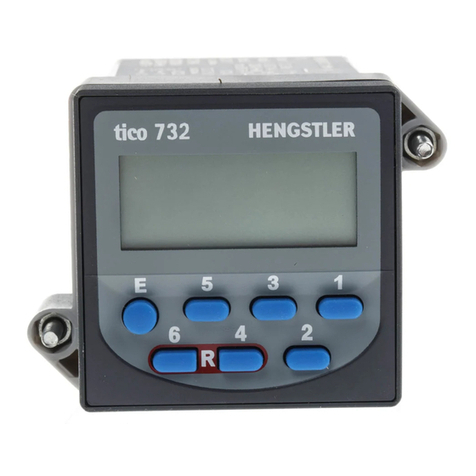
Hengstler
Hengstler tico 732 User manual

Hengstler
Hengstler Signo 721 User manual

